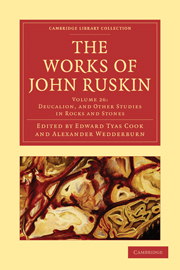Book contents
- Frontmatter
- Contents
- LIST OF ILLUSTRATIONS
- INTRODUCTION TO THIS VOLUME
- I ON THE FORMS OF THE STRATIFIED ALPS OF SAVOY (1863)
- II NOTES ON THE SHAPE AND STRUCTURE OF SOME PARTS OF THE ALPS, WITH REFERENCE TO DENUDATION (1865)
- III ON BANDED AND BRECCIATED CONCRETIONS (1867–1870)
- IV DEUCALION: COLLECTED STUDIES OF THE LAPSE OF WAVES AND LIFE OF STONES (1875–1883)
- V ON THE DISTINCTIONS OF FORM IN SILICA (1884)
- VI CATALOGUES OF MINERALS
- VII THE GRAMMAR OF SILICA (not hitherto published)
- APPENDIX: LETTERS, ADDRESSES, AND NOTES
- INDEX
- Plate section
III - ON BANDED AND BRECCIATED CONCRETIONS (1867–1870)
Published online by Cambridge University Press: 05 March 2012
- Frontmatter
- Contents
- LIST OF ILLUSTRATIONS
- INTRODUCTION TO THIS VOLUME
- I ON THE FORMS OF THE STRATIFIED ALPS OF SAVOY (1863)
- II NOTES ON THE SHAPE AND STRUCTURE OF SOME PARTS OF THE ALPS, WITH REFERENCE TO DENUDATION (1865)
- III ON BANDED AND BRECCIATED CONCRETIONS (1867–1870)
- IV DEUCALION: COLLECTED STUDIES OF THE LAPSE OF WAVES AND LIFE OF STONES (1875–1883)
- V ON THE DISTINCTIONS OF FORM IN SILICA (1884)
- VI CATALOGUES OF MINERALS
- VII THE GRAMMAR OF SILICA (not hitherto published)
- APPENDIX: LETTERS, ADDRESSES, AND NOTES
- INDEX
- Plate section
Summary
1. Among the metamorphic phenomena which seem to me deserving of more attention than they have yet received, I have been especially interested by those existing in the brecciate formations. They are, of course, in the main, twofold—namely, the changes of fragmentary or rolled-pebble deposits into solid rocks, and of solid rocks, vice versâ, into brecciate or gravel-like conditions. It is certainly difficult, in some cases, to discern by which of these processes a given breccia has been produced; and it is difficult, in many cases, to explain how certain conditions of breccia can have been produced either way. Even the pudding-stones of simplest aspect (as the common Molassenagelfluhe of North Switzerland) present most singular conditions of cleavage and secretion, under metamorphic action; the more altered transitional breccias, such as those of Valorsine, conceal their modes of change in a deep obscurity: but the greatest mystery of all attaches to the alterations of massive limestone which have produced the brecciated, or apparently brecciated, marbles: and to the parallel changes, on a smaller scale, exhibited by brecciated agate and flint.
2. The transformations of solid into fragmentary rocks may, in the main, be arranged under the five following heads:—
(i.) Division into fragments by contraction or expansion, and filling of the intervals with a secreted, injected, or infused paste, the degree of change in the relative position of the fragments depending both on their own rate and degree of division, and on the manner of the introduction of the cement.
- Type
- Chapter
- Information
- The Works of John Ruskin , pp. 35 - 84Publisher: Cambridge University PressPrint publication year: 2010First published in: 1906



